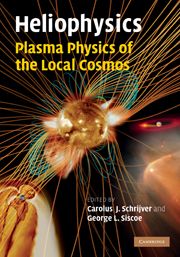Book contents
- Frontmatter
- Contents
- Preface
- 1 Prologue
- 2 Introduction to heliophysics
- 3 Creation and destruction of magnetic field
- 4 Magnetic field topology
- 5 Magnetic reconnection
- 6 Structures of the magnetic field
- 7 Turbulence in space plasmas
- 8 The solar atmosphere
- 9 Stellar winds and magnetic fields
- 10 Fundamentals of planetary magnetospheres
- 11 Solar-wind– magnetosphere coupling: an MHD perspective
- 12 On the ionosphere and chromosphere
- 13 Comparative planetary environments
- Appendix I Authors and editors
- List of illustrations
- List of tables
- References
- Index
7 - Turbulence in space plasmas
Published online by Cambridge University Press: 05 August 2013
- Frontmatter
- Contents
- Preface
- 1 Prologue
- 2 Introduction to heliophysics
- 3 Creation and destruction of magnetic field
- 4 Magnetic field topology
- 5 Magnetic reconnection
- 6 Structures of the magnetic field
- 7 Turbulence in space plasmas
- 8 The solar atmosphere
- 9 Stellar winds and magnetic fields
- 10 Fundamentals of planetary magnetospheres
- 11 Solar-wind– magnetosphere coupling: an MHD perspective
- 12 On the ionosphere and chromosphere
- 13 Comparative planetary environments
- Appendix I Authors and editors
- List of illustrations
- List of tables
- References
- Index
Summary
Preamble
In this chapter, we examine the concepts of hydrodynamic turbulence as they apply to space plasmas. We focus primarily on the solar wind at 1AU in order to illustrate the basic ideas of magnetohydrodynamic fluid turbulence in a unified and coherent fashion, but we extend these lessons to other space plasma systems. Of particular interest is the energy cascade that leads to heating of the background plasma. There is growing evidence that a turbulent dynamic does account for the in situ heating of the solar wind from 0.3 to 100AU. Turbulence may also provide an explanation for the coronal heating that accelerates the solar wind at the source. The discussion offered here is an attempt to explain how the fundamental ideas of turbulence apply to plasma dynamics. These thoughts are only a beginning, an introduction to the subject, but will lead the reader to the most recent and sometimes controversial ideas being discussed by the space physics and astrophysics communities.
Turbulence, by its rightful definition, is a branch of fluid dynamics. The term “plasma turbulence” has been used to denote the nonlinear evolution of dynamically coupled wave and particle populations, but this is something different. However, this raises an important point: the magnetohydrodynamic (MHD) systems of space physics are not true fluids but are plasmas that mimic magneto-fluid behavior at low frequencies. They retain their ability to exhibit purely plasma kinetic behavior such as the resonance of plasma waves with charged particle populations.
- Type
- Chapter
- Information
- Heliophysics: Plasma Physics of the Local Cosmos , pp. 163 - 194Publisher: Cambridge University PressPrint publication year: 2009
- 9
- Cited by



